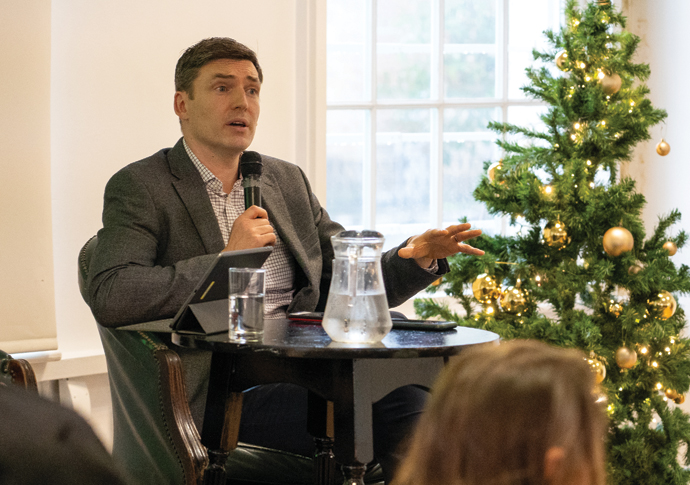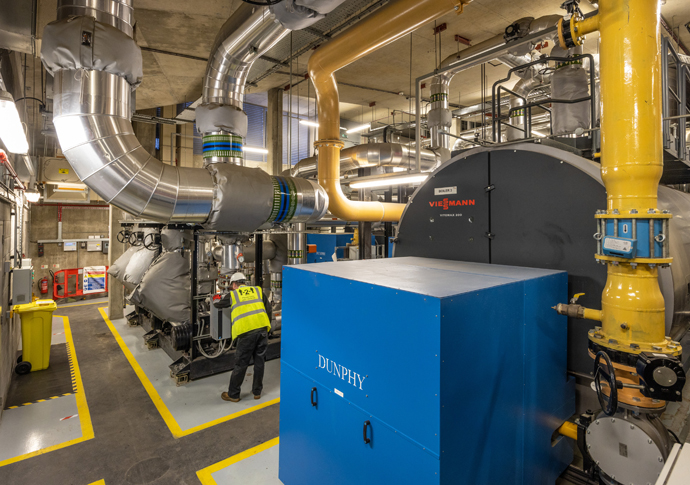How to win the race to net zero
Sustainability speaker at LDNCOP explains move away from fossil fuel
Friday, 15th December 2023 — By Dan Carrier

Jamie Quinn lays out the plan to retrofit and decarbonising the ‘energy centre’ [Alice Horsley]
DECARBONISING the energy centre and retrofitting existing buildings are two of the tools the King’s Cross estate is using to reach net zero carbon.
The 67-acre estate’s sustainability director Jamie Quinn spoke at the Tribune’s London COP event on Saturday, outlining the positive impact the neighbourhood is having on the environment and demonstrating best practice in creating a net zero carbon place to live, work and visit in an ever-expanding city.
Mr Quinn, who has worked in the field of sustainability for 20 years for both environmental charities and international organisations and was trained by Al Gore as a Climate Ambassador is leading King’s Cross’s sustainability strategy – including the procurement of 100 per cent renewable energy and the decarbonisation of its district energy centre.
“The role of a sustainability director is broad,” explained Mr Quinn. “I cover a range of disciplines and along with the wider team, we look at everything we do from an environmental and social perspective, as well as how we can support our local communities.
“Part of this is looking at our net zero carbon commitment, at energy supply, energy consumption, pollution, waste management, habitats, biodiversity, the circular economy, air quality, sustainable transport and the provision and consumption of water. It is about preserving and managing the precious resources we deal with.”

The King’s Cross Energy Centre will be decarbonised to reach net zero [Image courtesy of John Sturrock]
In 2021, our energy centre moved from using fossil fuel gas to a renewable green gas, supplied by an anaerobic digester facility in Scotland. The green gas provides heating and hot water for almost 1,750 homes and five million square feet of commercial space.
This week a commitment by King’s Cross to meet net zero by 2035 was ratified, and to do so Mr Quinn says there will be two key components.
“The first is the supply of energy,” he says.
“We have a district energy network in situ. It is efficient, but the technology has moved on.
“We are investing in transforming the energy plant into an electric network.”
This includes new air and ground source heat pumps.
“We will be putting in electric boilers, reducing the temperature across the network,” he added.
“We have looked at the demand side as well. How do we make sure buildings are working as efficiently as possible? This means specific interventions and includes everything from building management to behavioural change and more. When should heating be on and off? When should cooling systems be used?”
Upgrading technology, plant and building fabrics all supports operational efficiency.

More than 400 children, parents, and teachers unite for a two-kilometer run around King’s Cross, celebrating community fitness [Image courtesy of John Sturrock]
“The buildings are good in terms of performance but there is always more that can be done; net zero carbon isn’t just about the supply, it’s about consumption too,” he says.
Fresh investment in the estate’s net zero plans has a twin outcome: reducing emissions and addressing the climate emergency whilst also attracting the best tenants who expect the highest environmental and social standards.
“It is what people expect nowadays. Some of the global brands here have major ESG commitments and want to deliver on them locally,” he says.
For Mr Quinn, creating a green and sustainable place is not just about carbon emissions. It is also about considering how the King’s Cross estate can deliver positive outcomes for the communities that surround it.
“It is crucially important we look at our impact from a social perspective,” he adds.
“We must ensure that King’s Cross is inclusive and accessible. 40 per cent of the site is public realm, so it is just as important to consider the places and spaces between buildings as it is the actual buildings themselves.”
King’s Cross needs to offer something for everyone, from the students at the University of the Arts to the parents dropping children off at the King’s Cross Academy primary school. From visitors fresh off the Eurostar to residents living on site or nearby.
“The estate must engage with diverse needs. How do we measure this? It is not an easy thing to do. We must look at our impact on people’s quality of life,” Mr Quinn said.
This person-led approach is not a new idea. It was a key facet of the Principles for a Human City, the guiding document for development published by the team behind the King’s Cross estate in 2001.
“And it means that as the neighbourhood grows, we can look at our track record and consider what worked and what we can do better,” he added.
“The concept is to create a dynamic, varied and welcoming space that shows the true value of what we’re trying to achieve.”